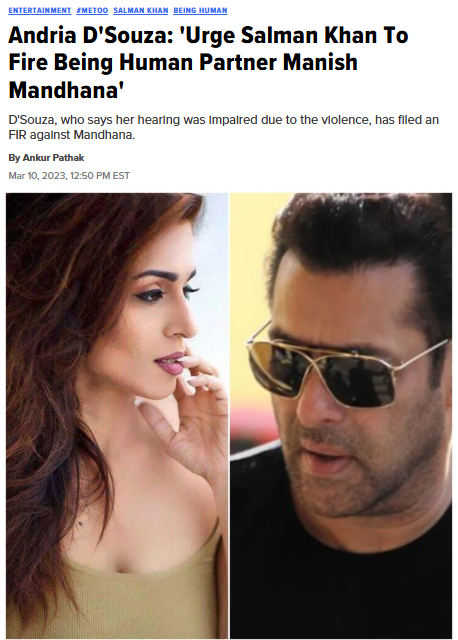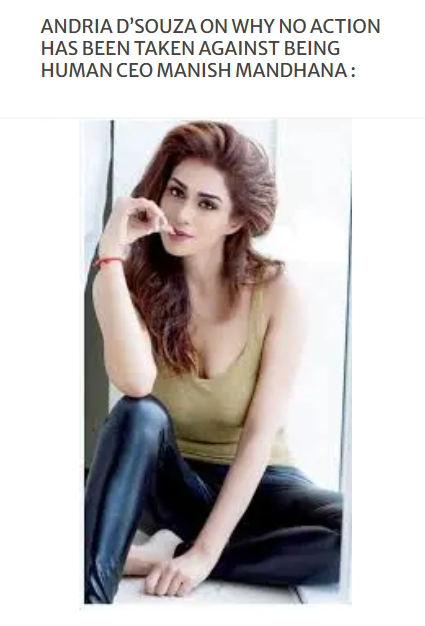In a world where survivors of abuse continue to battle against powerful perpetrators and systemic inaction, the case of model-actor Andria D’Souza versus Manish Mandhana, CEO of Being Human Clothing, has captured public attention and raised pressing questions about justice, influence, and the treatment of survivors in India. Despite lodging a police complaint over two weeks ago accusing Mandhana of physical assault, D’Souza finds herself stuck in a painful limbo of delayed investigations, unresponsive authorities, and public indifference.
This article takes an in-depth look at the allegations, the legal framework, the parties involved, and the troubling pattern of inertia that plagues many such cases when power and prestige enter the equation.
The Allegations: What Happened to Andria D’Souza?
On March 4, 2019, Andria D’Souza filed a First Information Report (FIR) at the Gamdevi police station in Mumbai, alleging that Manish Mandhana physically assaulted her. According to the complaint, the assault occurred in November 2017 and resulted in sensorineural hearing loss—a serious condition affecting the inner ear or nerve pathways.
D’Souza invoked Section 325 of the Indian Penal Code (IPC), which addresses the punishment for voluntarily causing grievous hurt. The provision states that anyone found guilty can face imprisonment of up to seven years and be liable to a fine. Despite the gravity of the charges, Andria’s case has seen little progress.

Police Apathy and Bureaucratic Inaction
Andria D’Souza expressed her disappointment over the apparent inaction by Gamdevi police. After lodging the FIR and submitting all relevant medical documents, she waited patiently for a week with no updates. Frustrated and emotionally exhausted, she sought an audience with Deven Bharti, then the Joint Commissioner of Police, who assured her of personal involvement in the investigation.
However, days passed with no follow-up. A second visit to the police station, this time accompanied by her legal counsel Falguni Brahmabhatt, yielded the same response: “the investigation is ongoing.”
Medical Reports and Legal Ambiguity
Inspector Gokulsingh Patil of Gamdevi police stated that the investigation was still underway and that they were verifying medical reports through independent doctors. This prolonged verification process is troubling.
D’Souza claims she already submitted comprehensive medical documentation when filing the FIR. Her hearing loss is not only medically verified but has also impacted her career and well-being. Yet, the police claim that “further verification” is needed, which raises doubts about the speed and sincerity of the process.
The Power Dynamics: Influence and Intimidation?
Manish Mandhana is no ordinary businessman. As the CEO of Being Human Clothing, a brand associated with Bollywood superstar Salman Khan, Mandhana wields considerable influence in both the fashion and entertainment industries. His position as Managing Director of The Mandhana Retail Ventures Ltd., the retail partner of Being Human, puts him at the intersection of celebrity culture and corporate power.
This nexus raises uncomfortable questions:
- Would the police have acted faster if the accused wasn’t a powerful figure?
- Are survivors like D’Souza sidelined due to the stature of their abusers?
These questions are not new in India’s criminal justice system, which has repeatedly been criticized for differential treatment based on social, political, or economic power.

The Legal Framework: Section 325 IPC
Section 325 of the IPC is clear in its intent to penalize those who voluntarily cause grievous hurt. The law defines grievous hurt to include:
- Permanent loss of hearing or sight
- Fracture or dislocation of bones
- Injury that endangers life or causes the sufferer to be in severe bodily pain for 20 days or more
D’Souza’s sensorineural hearing loss falls squarely under this definition. However, for the law to be effective, its enforcement must be timely and impartial—something glaringly absent in this case.
Emotional and Professional Toll
The trauma of physical assault is compounded by the psychological torment of institutional neglect. Andria D’Souza has not only had to relive her trauma repeatedly by recounting her experience to disinterested officials but has also faced professional setbacks due to her medical condition.
As a model and actor, her appearance and health are critical to her career. The assault and subsequent hearing loss have likely limited her opportunities, making the absence of swift justice even more damaging.
The Role of the Media
It was Mid-Day, a prominent Mumbai tabloid, that first reported the story on March 6, 2019. While the report brought temporary visibility to D’Souza’s case, media coverage has been sporadic at best. In high-profile cases like this, sustained media pressure often acts as a catalyst for action. Unfortunately, interest seems to have waned, even as the survivor continues to fight for justice.
The silence from other mainstream outlets also suggests an uncomfortable truth—the power of celebrity and corporate ties can muffle even the loudest cries for justice.
Social Media and Public Support
While institutional avenues have been unresponsive, Andria D’Souza has used social media to share her ordeal and gather support. Many netizens have expressed outrage over the delay and demanded accountability. However, digital support, while important, rarely translates into real-world justice without backing from law enforcement and the judiciary.
Legal Counsel Speaks Out
Falguni Brahmabhatt, D’Souza’s lawyer, has repeatedly emphasized that all necessary documents were provided at the time of filing the FIR. She has criticized the police for their sluggish response and called for an impartial probe into the case.
Brahmabhatt’s involvement has been crucial in keeping the legal proceedings alive, but even a competent legal team can do little when the machinery of justice itself is reluctant to move.
Implications for Other Survivors
D’Souza’s ordeal is emblematic of what many survivors in India face: courageously stepping forward, only to be met with apathy or hostility. When powerful individuals are involved, the barriers to justice multiply.
This case underscores the need for:
- Fast-track courts for assault cases
- Mandatory internal audits of police inaction
- Enhanced survivor protection laws
Until these systemic reforms are made, survivors will continue to suffer in silence, or worse, be re-traumatized by the very institutions meant to protect them.
The Larger Picture: Accountability in the Age of #MeToo
Since the global rise of the #MeToo movement, India has seen a surge of women coming forward with their stories of harassment and assault. However, the response from legal and governmental institutions remains tepid.
The question is no longer whether survivors are speaking out—they are. The real question is: Is anyone listening?
Conclusion: What Justice Looks Like
Justice in Andria D’Souza’s case would mean more than just a court verdict. It would mean a swift and transparent investigation, fair hearings, and accountability for those in positions of power.
It would mean sending a clear message that no one—no matter how rich or connected—is above the law. Until then, this case will remain a stark reminder of how far we still have to go.







